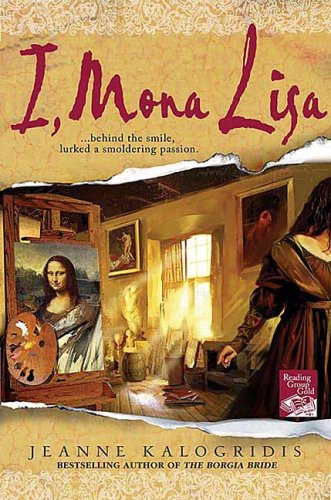
I, MONA LISA
Set against the drama and danger of fifteenth-century Florence, I, Mona Lisa is an intricately drawn tale, painted in many layers of fact and fiction. And through it all rings the captivating voice of Mona Lisa, immortalized by da Vinci but with the truth always hidden behind her smile…until now.
Florence, April 1478: The handsome Giuliano de’ Medici is brutally assassinated in Florence’s magnificent Duomo. The shock of the murder is felt throughout the great city, from the most renowned artists like Leonardo da Vinci and Michelangelo to a wealthy wool merchant and his extraordinarily beautiful daughter,
Set against the drama and danger of fifteenth-century Florence, I, Mona Lisa is an intricately drawn tale, painted in many layers of fact and fiction. And through it all rings the captivating voice of Mona Lisa, immortalized by da Vinci but with the truth always hidden behind her smile…until now.
Florence, April 1478: The handsome Giuliano de’ Medici is brutally assassinated in Florence’s magnificent Duomo. The shock of the murder is felt throughout the great city, from the most renowned artists like Leonardo da Vinci and Michelangelo to a wealthy wool merchant and his extraordinarily beautiful daughter, Madonna Lisa…
Over a decade later, Florence falls under the dark spell of the preacher Savonarola, a fanatic who burns paintings and books as easily as he sends men to their deaths. Lisa, now grown into an alluring woman, captures the heart of Giuliano’s nephew and namesake. But no sooner are they wed than Guiliano the younger meets a tragic end, and Lisa becomes caught in a tangled web of illicit love, treachery, and dangerous secrets that threaten her life.
From the author of the critically acclaimed The Borgia Bride comes another irresistible novel that seamlessly blends historical fact and gripping fiction.
- St. Martin's Griffin
- Paperback
- November 2006
- 544 Pages
- 9780312341398
About Jeanne Kalogridis
Jeanne Kalogridis lives with her partner in California, where they share a house with two dogs. She is the author of The Borgia Bride, and other numerous dark fantasy and historical novels.
Praise
“From sexual passion to mortal danger, the dramatic shift of real historical events will keep the reader turning the pages.” –Philippa Gregory, author of The Other Bolyn Girl about Jeanne Kalogridis’ novel The Borgia Bride
Discussion Questions
Few works of art are as romanticized and reproduced as the Mona Lisa. How did reading this book teach you about—or change your impression of—the art world’s most famous face? Have any of you seen it in person?
Beautiful, enigmatic, foreboding…many adjectives have been used to describe Lisa’s portrait. What words would you use to describe Lisa’s character? Also, talk about her role—as an only daughter, married woman, and member of the upper class—in Florentine society. How was Lisa different from other women of her era? Do you think she was a “woman ahead of her time?”
Lisa is told by her astrologer that she is “caught in a cycle of violence, of blood and deceit.” To what extent does Lisa let fate dictate her actions? Do you believe in fate? Discuss the themes of prophecy in I, Mona Lisa.
In addition to being religious, many of those we meet in the book become fanatic—and commit acts of violence to justify their beliefs. What was it that led Antonio, Baroncelli, and Savonarola to behave the way they did? Do you condone any of their actions?
Who do you think bears the true responsibility for the death of Giuliano the Elder? And Anna Lucrezia? How do the various characters—from Lisa to Antonio to Lorenzo—deal with the guilt, trauma, and mystery surrounding the deaths of those they love?
What is significant about the “third man” involved in Giuliano’s murder? How does this element of mystery drive the narrative of the book?
I, Mona Lisa is a novel about art and artifice. It is also about family—in all its glory and bloodshed. How important is the notion of family to each of the main characters? Which relationships are the most “real” to you in this book?
Do you believe that a picture is worth a thousand words? Can a work of art—a painting, a book—ever truly capture a person’s essence?
When Lisa views her portrait she feels it’s “more sacred, more profound than any image rendered by [a] mirror.” Why do you think she feels this way?
Leonardo is more than just an artist: he is a member of a powerful inner circle. What does I, Mona Lisa suggest about the role and function of art during the Medici era? Was it more or less “political” than it is now?
